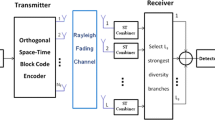Abstract
Orthogonal space–time codes (OSTCs) have recently captivated considerable attention due to their properties of full diversity and low implementation complexity. Quasi-orthogonal space–time codes (QOSTCs) provide full diversity and rate one, which enables simple pair wise decoding to be performed as well as better results to be obtained. In this paper, we derive effective OSTCs and QOSTCs for multi-input multi-output systems, which enable us to calculate coding gain of the OSTC. In addition, the fast maximum-likelihood (ML) decoding at the receiver can be performed separately. Since the QOSTC has a fast ML decoding, the symbol pairs can be decoded independently. With the constellation rotation of the symbol, rotated version of QOSTC is generated. OSTCs are designed to achieve the maximum diversity order for a given number of transmit and receive antennas subject to the constraint of having a simple decoding algorithm. This goal is achieved by properly choosing the signal constellations and comparing bit-error-rate (BER) to signal-to-noise ratio (SNR) for different quadrature pulse shift keying and quadrature-amplitude modulation techniques. The simulation results show that the QOSTC outperforms the OSTC at low SNR whereas it has higher complexity than the OSTC. From simulation result, we also compare the STC and space frequency code at BER versus SNR.








Similar content being viewed by others
References
Tarokh, V., Jafarkhani, H., & Calderbank, A. R. (1999). Space–time block codes from orthogonal designs. IEEE Transactions on Information Theory, 45, 1456–1467.
Guey, J. C., Fitz, M. P., Bell, M. R., & Kuo, W.-Y. (1996). Signal design for transmitter diversity wireless communication systems over Rayleigh fading channels. In Proceedings of IEEE VTC’96 (pp. 136–140).
Tarokh, V., Naguib, A., Seshadri, N., & Calderbank, A. R. (1999). Space–time codes for high data rate wireless communications: Performance criteria in the presence of channel estimation errors, mobility and multiple paths. IEEE Transactions on Communications, 47, 199–207.
Agrawal, D., Tarokh, V., Naguib, A., & Seshadri, N. (1998). Space–time coded OFDM for high data-rate wireless communication over wideband channels. In IEEE 48th vehicular technology conference (pp. 2232–2236). Ottawa, ON, Canada.
Alamouti, S. M. (1998). A simple transmit diversity technique for wireless communications. IEEE Journal on Selected Areas in Communications, 16(8), 1451–1458.
Sterian, C. E. D., Linga, S., Singh, R., & Piitzold, M. (2007). New super orthogonal space–time codes with 32QAM and two transmit antennas for five bits per signalling interval. European Transactions on Telecommunications, 18(2), 205–215.
Piitzold, M. & Rogstad, B. O. (2006). A wideband MIMO channel model derived from the geometric elliptical scattering model. In 3rd international symposium on wireless communication systems, ISWCS 2006 (pp. 138–143). Valencia, Spain.
Foschini, G., Gitlin, R., & Weinstein, S. (1974). Optimization of two dimensionalsignal constellations in the presence of gaussian noise. IEEE Transactions on Communications, 22, 28–38.
Jafarkhani, H. (2001). A quasi-orthogonal space–time block code. IEEE Transactions on Communications, 49, 1–4.
Papadias, C. B., & Foschini, G. J. (2003). Capacity-approaching space–time codes for systems employing four transmitter antennas. IEEE Transactions on Information Theory, 49, 726–732.
Su, W., & Xia, X. G. (2003). On space–time block codes from complex orthogonal designs. Wireless Personal Communications, 25(1), 1–26.
Liang, X. B. (2003). Orthogonal designs with maximal rates. IEEE Transactions on Information Theory, 49, 2468–2503.
Su, W., & Xia, X. G. (2004). Signal constellations for quasi-orthogonal space–time block codes with full diversity. IEEE Transactions on Information Theory, 50(10), 2331–2347.
Hammons, A. R, Jr, & El Gamal, H. (2000). On the theory of space–time codes for PSK modulation. IEEE Transactions on Information Theory, 46, 524–542.
Hochwald, B. M., & Sweldens, W. (2000). Differential unitary space–time modulation. IEEE Transactions on Communications, 48, 2041–2052.
Hou, J. & Lee, M. H. (2003). J-rotation space time block codes. In IEEE international symposium on information theory (ISIT) (p. 125).
Ranju, M. A. A. A., & Rafi, R. S. (2014). Analysis of rate one quasi-orthogonal space–time block coding over Rayleigh fading channel. International Journal of Communications Network and System Sciences, 7, 196–202.
Hou, J., & Lee, M. H. (2003). Matrices analysis of quasi-orthogonal space–time block codes. IEEE Communications Letters, 7(8), 385–387.
Acknowledgments
This work was supported by the MEST 2015R1A2A1A05000977, NRF, Korea.
Author information
Authors and Affiliations
Corresponding author
Rights and permissions
About this article
Cite this article
Hashem Ali Khan, M., Shin, T., Lee, M.H. et al. Signal Constellations of Quasi-Orthogonal Space–Time Codes for MIMO Systems. Wireless Pers Commun 85, 2003–2019 (2015). https://doi.org/10.1007/s11277-015-2887-z
Published:
Issue Date:
DOI: https://doi.org/10.1007/s11277-015-2887-z




